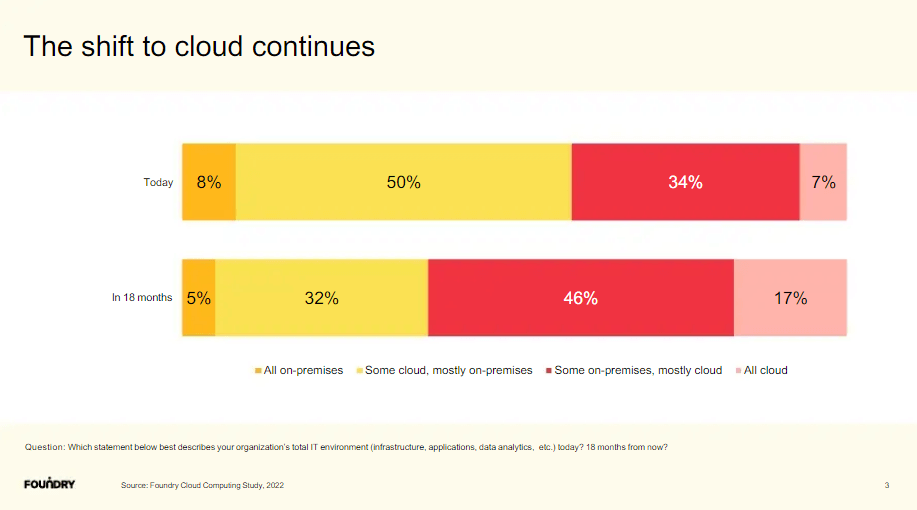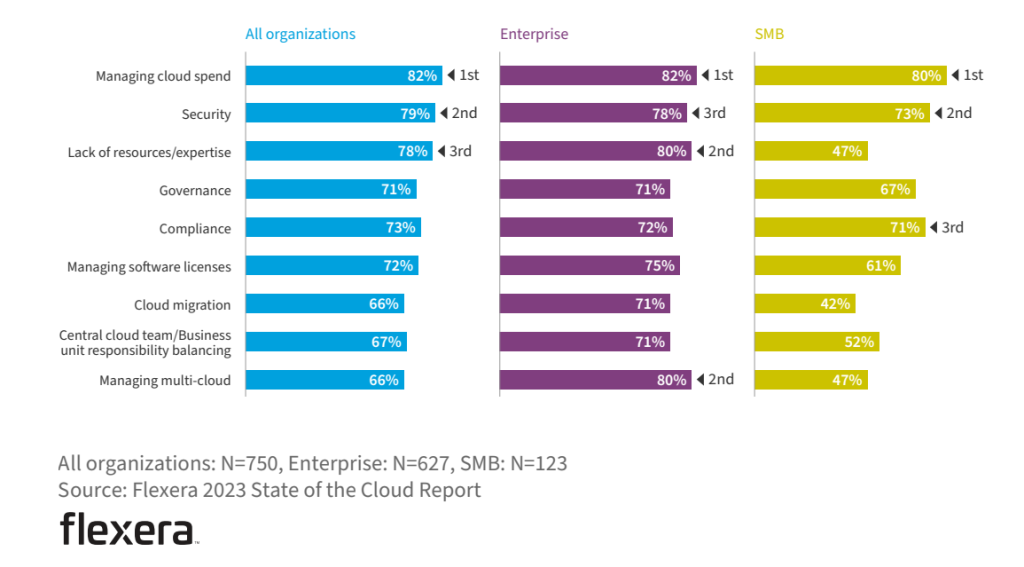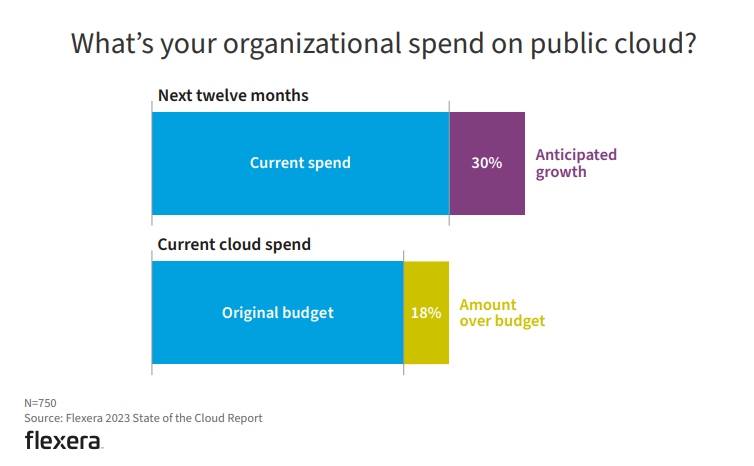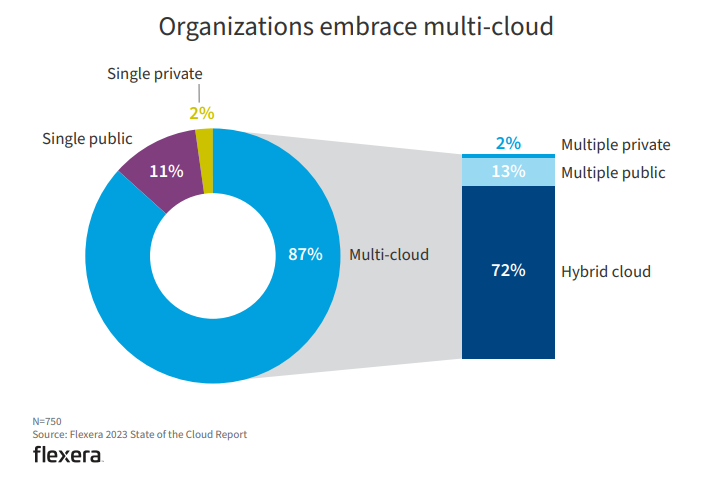
Everywhere you turn these days, “the cloud” is being talked about. It’s a hot topic, and as technologies continue to evolve at a rapid pace, the scope of the cloud continues to expand.
Yes, this ambiguous term seems to encompass almost everything about us. While “the cloud” is just a metaphor for the internet, cloud computing is what people are really talking about these days. It provides better data storage, data security, flexibility, improved organizational visibility, smoother processes, extra data intelligence, increased collaboration between employees, and changes the workflow of small businesses and large enterprises to help them make better decisions while decreasing expenses.
It is clear that utilizing the cloud is a trend that continues to grow – and will long into the future. We have already predicted the importance and implementation of the cloud in companies like Alibaba, Amazon, Google and Microsoft in our BI trends article earlier this year. Now, we’re going to dig a little deeper.
At this point, it’s worth noting that the significance of the cloud is increasing exponentially. In fact, Grand View Research suggests that the sector’s current value stands at an excess of $368.97 billion and is expected to expand at a rate of 15.7% (CAGR) between now and 2030.
Considering all the potential and development cloud computing has undergone in recent years, there are also many roadblocks businesses are facing. In this article, we have gathered the 13 most prominent challenges of cloud computing that will deliver fresh perspectives related to the market.
These challenges of cloud computing are not merely roadblocks to overcome. By understanding them and their nature in relation to the world of modern business, they present great opportunities for organizational growth and evolution.
But before we get to the potential problems with cloud computing, let’s start with a simple explanation of the general characteristics and basic definitions.
What Is Cloud Computing?
Cloud computing is the delivery of various hardware and software services over the internet through remote servers. These servers are busy storing, managing, and processing data that enables users to expand or upgrade their infrastructure and retrieve files on demand.
The capabilities and breadth of the cloud are enormous. The IT industry broke it into three categories to help better define use cases.
a) Software as a Service (SaaS) – software is owned, delivered, and managed remotely by one or more providers. To start, Software-as-a-Service, or SaaS, is a popular way of accessing and paying for software. Instead of installing software on your own servers, SaaS companies enable you to rent software that’s hosted, this is typically the case for a monthly or yearly subscription fee. More and more CRM, marketing, and finance-related tools use SaaS business intelligence and technology, and even Adobe’s Creative Suite has adopted the model.
b) Infrastructure as a Service (IaaS) – compute resources, complemented by storage and networking capabilities are owned and hosted by providers and available to customers on-demand.
c) Platform as a Service (PaaS) – the broad collection of application infrastructure (middleware) services. These services include application platform, integration, business process management, and database services.
All of this is a deviation from traditional on-premise computing, which is done via a local server or personal computer, are increasingly being left behind. In fact, Foundry’s recently published Cloud Computing Study (2022) found that 84% of organizations have at least one application or a portion of their computing infrastructure already in the cloud. And that the percentage of enterprises moving to a full cloud environment is expected to grow by 10% in the next 18 months.

It is evident that the cloud is expanding. Since we live in a digital age, where data discovery and big data simply surpass the traditional storage and manual implementation and manipulation of information, companies are searching for the best possible solution for handling data. Traditional spreadsheets no longer serve their purpose; there is just too much data to store, manage and analyze. Be it in the form of online BI tools, or an online data visualization system, a company must address where and how to store its data. Even the most traditional sectors have to adjust:
“In an effort to do everything from offer better in-store customer service to fully leverage advances in manufacturing, companies from even most traditional and change-resistant sectors are seeing the writing on the wall: Cloud technology strategies cut cost and risk.” – Lalit Bhatt, Project Leader at Maruti Techlabs.
Though the opportunities are great, this explosion hasn’t come without issues in cloud computing. We already discussed some of these cloud computing challenges when comparing cloud vs on premise BI strategies. Now let’s go over more of those challenges organizations are facing and how they are being addressed.
What Are The Challenges Of Cloud Computing?
Recently, Flexera conducted its annual State of the Cloud Survey on the latest cloud trends. They questioned 750 cloud decision-makers and users across a broad cross-section of organizations about their adoption of cloud infrastructure. Their findings were insightful, especially in regard to current challenges.

Starting with one of the major findings of this report, we can see that both enterprises and small businesses cite the ability to manage cloud spend as the biggest challenge, overtaking security concerns after a decade in place one. This can be the consequence of economic volatility, where organizations keep spending and innovating with multiple cloud services to keep up with the digital world in an unstable environment.
Still, as seen in the image above, security remains a close second for all organizations. Although it seems like, after multiple years of dealing with the issue, enterprises finally cite security as their third most pressing challenge, with a YoY comparison of 85% in 2022 vs. 78% in 2023. Naturally, small businesses can have a harder time managing due to a lack of resources or other elements, which puts security in second place for them.
Now, to answer the main question of what are the challenges for cloud computing in business, below we have expanded upon the most pressing ones that businesses of all sizes may need to address.
Let’s start with the ever-pressing subject of security risks in cloud computing.
1. Security issues
We mentioned the hot debate surrounding data protection in our definitive business intelligence trends guide. Like many other branches of technology, security is a pressing concern in the world of cloud-based computing, as you are unable to see the exact location where your data is stored or being processed. This increases the risks that can arise during the implementation or management process.
Currently, 93% of leading companies across sectors are highly concerned about experiencing a significant data breach within their cloud-centric ecosystems.
The main concerns surrounding cyber threats across the board are:
- Compromised credentials
- Broken authentication
- Human error
- Mass sensitive data breaches
- Hacked interfaces and APIs
- Account hijacking
In an age where cybersecurity is expected to cost a collective $10.5 trillion by 2025, these concerns are urgent and certainly not far-fetched fallacies.
All of this makes trusting sensitive and proprieties of cloud computing. Luckily as suppliers and users, mature fortification capabilities are constantly improving. To ensure your organization’s privacy and cybersecurity are intact, verify the SaaS provider has secure user identity management, authentication, and access control mechanisms in place. Also, check which database privacy and security laws they are subject to.
While you are auditing a provider’s protection and privacy laws, make sure also to confirm the third biggest issue is taken care of: compliance. Your organization needs to be able to comply with regulations and standards, no matter where your data is stored. Speaking of storage, also ensure the provider has strict data recovery policies in place. This way, in the eventuality of a cyberattack, you’ll be able to limit the damage and recover the data that was stolen from you. Something that is not usually possible when working with on-premise solutions.
Even though security is no longer the biggest issue for organizations, it has been a reality and a cause for concern for over a decade and remains at the top of the list even today. While there are many innovations and technologies that cloud services offer to ensure security, privacy, and compliance across the board, it is the responsibility of the company to make sure these policies are in place before investing in a solution. As mentioned before, the consequences of poor security management can break a company from a financial and reputational perspective; that’s why it is important to implement a secure BI cloud tool that can leverage proper security measures.
By keeping your finger on the pulse of emerging trends and understanding the cybersecurity capabilities of every entity within your ecosystem, you will reduce the threat of breaches or attacks significantly.
2. Cost management and containment
The next part of our cloud computing risks list involves costs. As mentioned before, expenses have been cited as the biggest cloud-related issue for organizations of all sizes today. It is not a surprise that the cloud industry is still growing at an increasing pace, with new tools and technologies emerging every day. In that regard, respondents of the Flexera report stated that their current cloud spending was 18% over the initial budget, an increase from 13% in 2022. Still, they expect the number to go up as high as 30% in the next 12 months.

For the most part, modern computing can save businesses money in the long run. In the cloud, an organization can easily ramp up its processing capabilities without making large investments in new hardware. Businesses can instead access extra processing through pay-as-you-go models from public providers. However, the on-demand and scalable nature of cloud computing services makes it sometimes difficult to define and predict quantities and costs. That said, as the market becomes more and more competitive, suppliers are constantly offering discounts and deals as retention and acquisition strategies. Businesses are taking advantage of those deals as key cost-saving measures.
Furthermore, organizations use many other strategies to optimize their cloud spending. Flexera cites automated processes such as utilization monitoring and shutting down workloads after hours as the biggest ones. Implementing tags is another popular strategy to optimize costs. However, only 34% of respondents use them.
Luckily there are several other ways to keep cloud costs in check, for example, optimizing costs by conducting better financial analytics and reporting, automating policies for ruling, or keeping the management reporting practice on the course so that these issues in computing could be decreased.
Another recent innovation that helps mitigate costs and tackle this most pressing of issues in cloud computing is multi-cloud computing tools. Currently, 32% of businesses use multi-cloud cybersecurity tools to reduce the financially devastating risk of data breaches, while 31% of leading enterprises use direct multi-cloud cost management tools to mitigate financial efficiency across the organization. In both cases, the return on investment (ROI) is healthy. As such, we expect to see an increase in adoption in the near future.
3. Lack of resources/expertise
One of the cloud computing challenges companies and enterprises are facing today is a lack of resources and/or expertise. This was already an issue before the pandemic and became an even bigger one after it as cloud technologies rapidly advanced during that period, leading organizations to lose revenue and even market share because of the lack of technical skills to manage their demands.
Due to these factors, organizations are having a tough time keeping up with the tools. Also, the need for expertise continues to grow. In fact, The Wall Street Journal reported that in 2020, the demand for cloud computing jobs was 94% higher than in 2017. The biggest issue is that companies are struggling to find the right talent as they are competing with big players such as Google or Amazon. Nevertheless, these challenges can be minimized through additional training of IT and development staff. A strong CIO championing cloud adoption also helps. As Cloud Engineer Drew Firment puts it:
“The success of adoption and migrations comes down to your people — and the investments you make in a talent transformation program. Until you focus on the #1 bottleneck to the flow of cloud adoption, improvements made anywhere else are an illusion.”
SME (small and medium-sized) organizations may find adding specialists to their IT teams to be prohibitively costly. Luckily, many common tasks performed by these specialists can be automated. To this end, companies are turning to DevOps tools, like Chef and Puppet, to perform tasks like monitoring usage patterns of resources and automated backups at predefined time periods. These tools also help optimize the cloud for cost, governance, and security.
The situation might be a bit different for large enterprises, as the adoption of the cloud is way bigger and more complex. In that sense, these corporations are turning their efforts into training their employees but also exclusively hiring professionals with the required experience and talent, for example, in cloud automation.
4. Governance/Control
Moving on with the problems of cloud computing, we have control in place four. Proper IT governance should ensure IT assets are implemented and used according to agreed-upon policies and procedures, ensure that these assets are properly controlled and maintained, and ensure that these assets are supporting your organization’s strategy and goals.
In today’s cloud-based world, IT does not always have full control over the provisioning, de-provisioning, and operations of infrastructure. This has increased the difficulty for IT to provide the governance, compliance, risks, and data quality management required. To mitigate the various risks and uncertainties in transitioning to the cloud, IT must adapt its traditional IT control processes to include the cloud. To this effect, the role of central IT teams in the system has been evolving over the last few years. Along with business units, central IT is increasingly playing a role in selecting, brokering, and governing cloud services. On top of this, third-party cloud computing/management providers are progressively providing support and best practices.
5. Compliance
One of the risks of cloud computing is compliance. That is an issue for anyone using backup services or storage. Every time a company moves data from internal storage to a cloud, it is faced with being compliant with official regulations and laws. For example, healthcare organizations in the USA have to comply with HIPAA (Health Insurance Portability and Accountability Act of 1996), public retail companies have to comply with SOX (Sarbanes-Oxley Act of 2002), and PCI DSS (Payment Card Industry Data Security Standard).
Depending on the sector and requirements, every organization must ensure these standards are respected and carried out.
This is one of the many challenges facing cloud computing, and although the procedure can take a certain amount of time, the data must be properly stored.
Customers need to look for vendors that can provide compliance and check if they are regulated by the standards they need. Some vendors offer certified compliance, but in some cases, additional input is needed on both sides to ensure proper compliance regulations.
6. Network dependence
Next, in our list of challenges and risks in cloud computing, we have network dependence. In order for businesses to successfully transfer massive volumes of data in real-time to and from the cloud internet bandwidth plays a key role. However, this is not always a given, as internet can present problems and unexpected outages that can significantly harm the business.
For some, the solution is easy, invest in quality networks with premium bandwidth. Now, this might be an easy fix for enterprises that can assume the increase in costs. However, SMBs are still struggling to keep up with the overall spending of the cloud in general. Therefore, this presents a limitation.
Still, this is a straightforward challenge that requires the right investment and infrastructure as well as good practices to manage and avoid any potential downtime.
7. Managing multiple clouds
Cloud computing challenges haven’t just been concentrated in one single cloud.
The state of multi-cloud has grown exponentially in recent years. Companies are shifting or combining public and private clouds, and, as mentioned earlier, tech giants like Alibaba and Amazon are leading the way.
The survey by Flexera mentioned above shows that 87% of enterprises have a multi-cloud strategy, a decrease from 89% last year. Enterprises with a hybrid strategy (combining public and private clouds) reach 72%, also decreasing from 80% last year. What’s interesting is that while the overall use of multi-cloud strategies decreased a bit from the previous year, organizations with a strategy of multiple public clouds grew from 7% to 13%, meaning we might see a shift in this direction in the coming years when it comes to multi-cloud.

That said, the major change appears to be a shift from using a hybrid strategy to only a single public cloud. With an increase to 24% in 2023, compared to 16% in 2022.
Still, most organizations leverage an average of almost five clouds, it is evident that the use of the cloud will continue to grow. That’s why it is important to answer the main questions organizations are facing today: what are the challenges for cloud computing, and how to overcome them?
To achieve multiple management success and overcome the continual difficulties associated with systemic complexity, here are some best practices to consider:
- Work with a multi-management specialist or partner that will help you integrate every key component of your system based on your specific needs
- Work with hybrid operating models if possible, as these innovations will help you manage public and private information both securely and seamlessly
- Adopt different protocols and management styles for each component of your ecosystem rather than taking a one-size-fits-all approach
8. Performance
When an organization moves to the cloud, it becomes dependent on the service providers. The next prominent challenge expands on this partnership. Nevertheless, this partnership often provides businesses with innovative technologies they wouldn’t otherwise be able to access. On the other hand, the performance of the organization’s BI and other cloud-based systems is also tied to the performance of the provider when it falters. When your provider is down, you are also down.
This isn’t uncommon; over the past couple of years, all the big players have experienced outages. Make sure your provider has the right processes in place and that they will alert you if there is ever an issue.
For the data-driven decision making process, real-time data for organizations is imperative. Being able to access data that is stored on the cloud in real time is one of the imperative solutions an organization has to consider while selecting the right partner.
With an inherent lack of control that comes with cloud computing, companies may run into real-time monitoring problems. Make sure your SaaS provider has real-time monitoring policies in place to help mitigate these potential difficulties.
9. Building a private cloud
Although building a private ecosystem isn’t a top priority for many organizations, for those who are likely to implement such a solution, it quickly becomes one of the main challenges facing cloud computing – private solutions should be carefully addressed.
Creating an internal or private cloud will cause a significant benefit: having all the data in-house. But IT managers and departments will need to face building and gluing it all together by themselves, which can cause one of the challenges of moving to cloud computing extremely difficult.
It is important to keep in mind also the steps that are needed to ensure the smooth operation of the cloud:
- Automating as many manual tasks as possible with the help of modern BI software (which would require an inventory management system)
- Orchestration of tasks has to ensure that each of them is executed in the right order.
As this article stated: the software layer has to grab an IP address, set up a virtual local area network (VLAN), put the server in the load balancing queue, put the server in the firewall rule set for the IP address, load the correct version of RHEL, patch the server software when needed and place the server into the nightly backup queue.
That being said, it is obvious that developing a private cloud is no easy task, but nevertheless, some organizations still manage and plan to do so in the next years.
10. Segmented usage and adoption
Most organizations did not have a robust cloud adoption strategy in place when they started to move to the cloud. Instead, ad-hoc strategies sprouted, fueled by several components. One of them was the speed of adoption. Another one was the staggered expiration of data center contracts/equipment, which led to intermittent cloud migration. Finally, there also were individual development teams using the public cloud for specific applications or projects. These bootstrap environments have fostered full integration and maturation problems, including:
- Isolated projects lacking shared standards
- Ad hoc security configurations
- Lack of cross-team shared resources and learnings
In fact, a recent survey by IDC of 6,159 executives found that just 3% of respondents define their cloud strategies as “optimized”. Luckily, centralized IT, strong governance and control policies, and some heavy lifting can get usage, adoption, and cloud computing strategies in line.
Nearly half of the decision-makers believe that their IT workforce is not completely prepared to address the cloud computing industry challenges and manage their cloud resources over the next 5 years. Since businesses are adopting the strategy more often than ever, it is eminent that the workforce should keep up and carefully address the potential difficulties.
11. Migration
One of the main cloud computing sector problems in recent years concentrates on migration. This is the process of moving an application to the cloud. Although moving a new application is a straightforward process, when it comes to moving an existing application to a new environment, many cloud difficulties arise.
Many leading companies are currently migrating their applications to the cloud, and over half of them find it more difficult than expected – projects are over budget and deadline.
What are the problems faced during storing data in a cloud-centric ecosystem? The most commonly cited were:
- Extensive troubleshooting
- Cybersecurity challenges
- Slow data migrations
- Migration agents
- Cutover complexity
- Application downtime
- Dependency mapping
- Assessing technical feasibility
- Understanding application dependencies
- Cost-optimization after migration
In a recent sector report from Flexera, 51% of businesses confirm that understanding app dependencies is a significant roadblock to successful migration, while 49% state that assessing technical feasibility is their primary issue.
But while this is the case, a greater understanding of migration concepts and frameworks, as well as an evolution of tools or platforms within the sector, has driven down these difficulties from 2021, with slightly fewer organizations struggling with these types of cloud computing issues.
12. Portability and interoperability
The next of our cloud computing problems is a decidedly operational roadblock. When organizations scale or expand their intangible IT ecosystems, one of the biggest problems with cloud computing from a logistical standpoint is moving from one provider or platform to another.
Typically, when a company switches to a new platform, there is a lockdown period that puts a kink in the network, driving down productivity in the process. This significant lack of flexibility results in a raft of issues:
- Safe and fluent data migration and management
- Establishing secure and compliant networks, essentially from scratch
- Restricted user or customer access
These glaring roadblocks have become more prevalent in recent years due to the increasing complexity of tools, platforms, and systems.
One of the most effective ways to counteract these tricky risks of cloud computing is to go through relevant data and service laws in your region to understand your portability rights while working out concrete terms with potential providers to prevent lockdown periods or service restrictions in advance.
13. Reliability and availability
Last but certainly not least in our definitive rundown of performance challenges in cloud computing is a question of reliability and availability.
As we migrate towards an age where 94% of organizations use cloud-based service providers (CSPs) or platforms in some way, shape, or form, being able to ensure the right data is available at any given point in time while retaining system functionality has emerged as one of the modern age’s most significant issues with cloud computing.
Due to the broadening of modern platforms and computing-centric ecosystems, an increasing number of companies rely on third-party management platforms. The problem with this is that many suppliers offer round-the-clock service that results in system outages that can cause momentary devastating or monetary losses.
To ensure that your system is both available and reliable at any given point in time, it’s important to have stringent plans in place to monitor key performance and operational aspects, including system robustness, core functionality, SLAs, data quality, and overall performance. Armed with a solid strategic framework, you can ensure your providers are held fully accountable while preventing any outages or availability problems.
In the End – The Cloud Still Wins
It is no secret; that cloud computing is revolutionizing the IT industry. It is also shaking up the business intelligence (BI) landscape and, well, pretty much everything else it touches. As adoption exponentially grows, organizations of all sizes are realizing the benefits. For startups and small to medium-sized businesses (SMBs), that can’t afford costly server maintenance but also may have to scale overnight, the benefits of utilizing the cloud are especially great.
While cloud computing challenges do exist, if properly addressed, these 13 challenges don’t mean your IT roadmap has to remain anchored on-premise. Business intelligence (BI) and the cloud are an ideal match, as the first one provides the right information to the right people, while the latter is an agile way to access BI solutions and applications.
To make the best out of this new age of IT facilitation and overcome any potential roadblocks, you should take a strategic iterative approach when it comes to implementing your system. Explore hybrid cloud solutions, involve business and IT teams, invest in a CIO, and choose the right BI SaaS partner. All of these strategic measures will ensure that the benefits of cloud business intelligence far outweigh the potential risks.
Speaking of the innate value of migrating to a new flexible IT-centric system, here are the key advantages of cloud computing in business:
- Saving costs: By adopting modern CSPs and methods, you will drive down the costs associated with business operations and IT infrastructure. While it may bear a notable cost to set everything up, the ROI you will enjoy as a result of safety, fluency, efficiency, and operational vision will pay back tenfold over the years.
- Safety: As we mentioned earlier, cybersecurity is on the rise. But if you can overcome any roadblocks related to data breaches, you will create a network that will fortify every sensitive area of your business, protecting yourself from the threat of devastating cyberattacks.
- System mobility: Another key benefit of using modern CSP functionality is the ability to access key data and system functionality from multiple devices wherever you are in the world, 24/7. Gaining this increased mobility will increase productivity, make your organization more responsive, and boost employee satisfaction by giving them the tools to perform better at their jobs.
- Improved insight: In the modern age, knowledge equals power, and data equals money. By working with CSP-based technologies, you can gain improved access to data-driven insights in a way that is centralized, efficient, and digestible. As such, with CSPs and modern IT-based capabilities, it’s possible to drive innovation by achieving greater business intelligence (BI).
- Boost collaboration: A big part of the success of an organization relies on collaboration. After all, the different departments and teams are all working towards the same general company goals. Cloud computing can help boost collaboration through more innovative and engaging channels. This way, they’ll avoid tedious in-presence meetings and develop joint strategies in an online environment.
- Quality control: If you are a regular reader of this blog, then you must be aware of the consequences bad quality data and reporting can bring to an organization’s growth efforts. Cloud-based services store all relevant data in one secure location with a unique format. This way, you can ensure consistency, avoid manual errors, and keep close control of any accesses or manipulations of critical business data.
- Loss & recovery: No matter how efficient your company is at managing all its data-related processes, accidents and issues can still happen. On-premise solutions often require long recovery processes, and even then, it is not a given that you’ll be able to recover what you lost. On the other hand, cloud-based solutions offer quick data recovery processes for multiple emergency situations, such as server cyberattacks or regular outages.
- Faster time to market: Last but not least, cloud computing sets the perfect environment for innovation at a faster and more efficient pace. You can think of a new idea, develop it, test it, and launch it, or retire it immediately if it doesn’t work. There is no need to design complex applications or go through tedious processes.
The Future Of Cloud Computing
There’s no denying it: We’ve reached a new, more innovative age where organizations are taking charge of their technological destinies.
But while the prospective benefits and challenges of cloud computing do exist, with greater adoption comes an increased challenge. As the technology evolves within enterprise IT, it’s vital that senior decision-makers take measures to understand these risks in detail to mitigate them if they materialize.
As for the future, experts predict that leading CSPs will operate at an almost ATM-style capacity to offer various subsets of their services. This flexible approach will indeed make it easier for organizations to ‘self-serve’ as and when they need to without adopting these services with strategic caution (while understanding the risks).
Another notable evolution of the CSP landscape will come in the form of an increased need for specialist skills to support mass system upgrades and migration. To remain robust and scale seamlessly, organizations will need internal talent to improve or expand their CSP infrastructures with pinpoint accuracy and complete confidence. With this in mind, to thrive in tomorrow’s world, it’s important to adopt a data-driven organizational culture while upskilling relevant technical personnel in the art of cloud-centric management and migration.
For the coming years, providers are expected to make big investments in machine learning and artificial intelligence technologies to boost their products and services with more advanced functionalities. However, as we’ve seen in other industries, the use of AI and ML comes with security concerns that need to be addressed. Therefore, we can also expect to see an even bigger focus on security in the cloud computing environment and also more regulations from the governmental side as the market continues to grow.
As these new technologies and innovations are introduced and new providers go into the market, we can expect a more competitive environment in terms of prices. In that sense, providers will need to come up with smart strategies to compete with bigger players in the industry. For example, by offering discounts and special packages or subscriptions to consumers as retention and acquisition strategies.
Clearly, organizations have some demanding work ahead of them, especially since the adoption of the cloud has now emerged as a business standard. CSP infrastructures aren’t something to roll out in the blink of an eye – care, caution, and an understanding of the prospective issues and opportunities are vital for long-term innovation and success.
A strategic approach that encompasses management details and professionals’ involvement can help reduce potential risks, costs, and flaws in the implementation process. The future of the cloud lies in introducing industry standards that will help in addressing regulatory, management, and technological matters.
Key Takeaways
As we reach the end of this insightful guide, we hope you have a clear understanding of the pros and cons of cloud computing and how this industry will continue to mutate and grow in the coming years. We went through 13 challenges and some solutions that you can apply to limitate the risks. Being aware of these potential issues is a great way to start on the right foot and mutate your business to a cloud environment.
To summarize, here are the top limitations or issues in cloud computing:
- Cybersecurity issues
- Cost management and containment
- Lack of resources/expertise
- Governance/Control
- Compliance
- Network dependence
- Managing multiple clouds
- Performance
- Building a private cloud
- Segmented usage and adoption
- Migration
- Portability and interoperability
- Reliability and availability
To start your own cloud research and utilize the potential it can provide to your business, try our software for a 14-day trial! It’s completely free!

